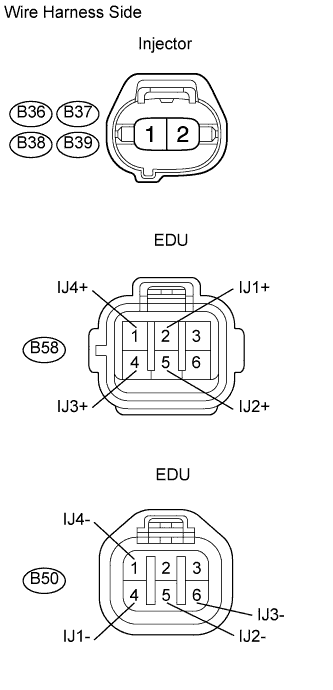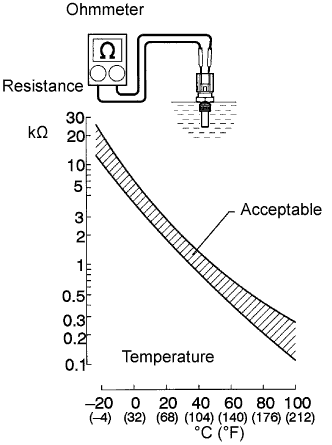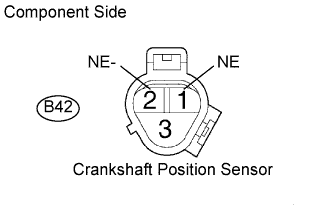2ad-fhv problems
Engine Difficult to Start or Stalling
Inspection procedure
NOTICE:
- After replacing the ECM, the new ECM needs registration and initialization.
- After replacing a supply pump, the ECM needs initialization.
- After replacing an injector, the ECM needs registration.
HINT:
- Specified values in the following troubleshooting flowchart are for reference only. Variations in the Data List values may occur depending on the measuring conditions or the vehicle's age. Do not assume the vehicle is normal when the Data List outputs standard values. There may be concealed factors of the malfunction.
- If the vehicle runs out of fuel while the engine is operating, there is a chance that the engine may be difficult to restart after the fuel is refilled.
| 1.CHECK OUTPUT DTC (RELATED TO ENGINE) |
-
Connect the intelligent tester to the DLC3.
-
Turn the ignition switch on (IG) and turn the tester ON.
-
Enter the following menus: Powertrain / Engine and ECT / DTC.
-
Read DTCs.
Result:Display (DTC Output) Proceed to No output A DTCs related to engine B
|
|
||||
| A | |
| 2.CHECK FUEL FILTER ASSEMBLY |
-
Check that the fuel filter is not clogged.
OK:
Fuel filter is not clogged.
|
|
||||
| OK | |
| 3.CHECK ENGINE CRANKING CONDITION |
-
Check the engine cranking condition.
-
Compare the cranking condition with that of a normal engine of the same model, and carefully check if there is any difference between them.
OK:
Engine cranking condition is normal.
|
|
||||
| OK | |
| 4.READ VALUE OF FUEL PRESSURE SENSOR |
-
Connect the intelligent tester to the DLC3.
-
Turn the ignition switch on (IG) and turn the tester ON.
-
Enter the following menus: Powertrain / Engine and ECT / Data List / Fuel Press.
-
Read the value.
Standard value:
Item Inspection Condition Reference Value Fuel Press Cranking, and engine coolant temperature 0°C (32°F) or more 20 to 55 MPa
|
|
||||
| OK | |
| 5.CHECK IF INITIAL COMBUSTION OCCURS |
-
Check if initial combustion occurs.
Result:Result Proceed to No initial combustion with cold engine A No initial combustion with hot engine B Initial combustion occurs C
|
|
||||
|
|
||||
| A | |
| 6.CHECK GLOW INDICATOR LIGHTING TIME AND AFTER-GLOW TIME |
-
Check the lighting duration of the glow indicator light.
OK:
Indicator lighting time is normal.
|
|
||||
| OK | |
| 7.READ VALUE OF FUEL PRESSURE SENSOR |
-
Connect the intelligent tester to the DLC3.
-
Start the engine and turn the tester ON.
-
Enter the following menus: Powertrain / Engine and ECT / Data List / Fuel Press.
-
Check that the internal fuel pressure of the common rail is within the specification below.
Standard value:
Engine Speed Fuel Pressure Idling Approximately 37 to 43 MPa 3,000 rpm (No engine load) Approximately 60 to 66 MPa
|
|
||||
| OK | |
| 8.CHECK AIR INTAKE SYSTEM AND EXHAUST SYSTEM |
-
Inspect the engine condition.
|
|
||||
| OK | |
| 9.READ VALUE OF FUEL PRESSURE SENSOR AND INJECTOR |
-
Connect the intelligent tester to the DLC3.
-
Start the engine and turn the tester ON.
-
Enter the following menus: Powertrain / Engine and ECT / Data List.
-
Select the following menu items in order and read the values.
- Fuel Press
- Injection Volume
Standard value:
Item Engine Speed* Reference Value Fuel Press Idling 37 to 43 MPa Fuel Press 2,000 rpm (No engine load) 47 to 53 MPa Fuel Press 3,000 rpm (No engine load) 60 to 66 MPa Injection Volume Idling 3.9 to 7.0 mm3 Injection Volume 2,000 rpm (No engine load) 5.6 to 9.1 mm3 Injection Volume 3,000 rpm (No engine load) 7.9 to 11.4 mm3 HINT:
*: If no idling conditions are specified, the shift lever should be in the neutral position, and the A/C switch and all accessory switches should be OFF.
|
|
||||
| OK | |
| 10.CHECK CYLINDER COMPRESSION PRESSURE |
-
Check the cylinder compression pressure.
Standard pressure:
2,700 kPa (27.5 kgf/cm2, 392 psi)
Minimum pressure:
2,200 kPa (22.4 kgf/cm2, 319 psi)
Difference between each cylinder:
500 kPa (5.1 kgf/cm2, 73 psi)
|
|
||||
| OK | |
| 11.CHECK WIRE HARNESS (INJECTOR - EDU) |

-
Disconnect the B36, B37, B38, and B39 injector connectors.
-
Disconnect the B50 and B58 EDU connectors.
-
Measure the resistance of the wire harness side connectors.
Standard resistance:
Tester Connection Specified Condition B36-1 - B58-2 (IJ1+) Below 1 ? B37-1 - B58-5 (IJ2+) Below 1 ? B38-1 - B58-4 (IJ3+) Below 1 ? B39-1 - B58-1 (IJ4+) Below 1 ? B36-2 - B50-4 (IJ1-) Below 1 ? B37-2 - B50-5 (IJ2-) Below 1 ? B38-2 - B50-6 (IJ3-) Below 1 ? B39-2 - B50-1 (IJ4-) Below 1 ? B36-1 or B58-2 (IJ1+) - Body ground 10 k? or higher B37-1 or B58-5 (IJ2+) - Body ground 10 k? or higher B38-1 or B58-4 (IJ3+) - Body ground 10 k? or higher B39-1 or B58-1 (IJ4+) - Body ground 10 k? or higher B36-2 or B50-4 (IJ1-) - Body ground 10 k? or higher B37-2 or B50-5 (IJ2-) - Body ground 10 k? or higher B38-2 or B50-6 (IJ3-) - Body ground 10 k? or higher B39-2 or B50-1 (IJ4-) - Body ground 10 k? or higher -
Reconnect the injector connectors.
-
Reconnect the EDU connectors.
|
|
||||
| OK | |
| 12.PERFORM ACTIVE TEST BY INTELLIGENT TESTER (CONTROL CYLINDER FUEL CUT) |
-
Connect the intelligent tester to the DLC3.
-
Start the engine and turn the tester ON.
-
Enter the following menus: Powertrain / Engine and ECT / Active Test / Control the Cylinder #1, #2, #3 and #4 Fuel Cut.
-
Check the engine idle speed while the fuel injection to each cylinder is cut using the tester.
Result:Engine Idling Condition Proceed to Becomes unstable A Does not change B HINT:
Replace the injector mounted on the cylinder that causes no significant idle speed change.
|
|
||||
| A | |
|
| 13.CHECK IF FUEL IS BEING SUPPLIED TO SUPPLY PUMP |
-
Disconnect the inlet hose from the supply pump.
-
Operate the priming pump and check that the fuel is being supplied to the supply pump.
OK:
Fuel is properly supplied to the supply pump when the priming pump is operated.
-
Reconnect the inlet hose.
|
|
||||
| NG | |
|
| 14.READ VALUE USING INTELLIGENT TESTER (ENGINE COOLANT TEMPERATURE) |
-
Connect the intelligent tester to the DLC3.
-
Turn the ignition switch on (IG) and turn the tester ON.
-
Enter the following menus: Powertrain / Engine and ECT / Data List / Coolant Temp.
-
Read the value.
Standard value:
Between 75 and 95°C (167 and 203°F) with warm engine.
|
|
||||
| OK | |
| 15.READ VALUE USING INTELLIGENT TESTER (ENGINE SPEED) |
-
Connect the intelligent tester to the DLC3.
-
Turn the ignition switch on (IG) and turn the tester ON.
-
Enter the following menus: Powertrain / Engine and ECT / Data List / Engine Speed.
-
Read the value.
Standard value:
Between 750 to 1,000 rpm with warm engine (A/C switch OFF).
|
|
||||
| OK | |
| 16.CHECK WIRE HARNESS (STARTER RELAY OR IGNITION SWITCH - ECM) |

w/ Entry and start system:

-
Remove the ST relay from the No. 8 relay block.
-
Disconnect the A12 ECM connector.
-
Measure the resistance of the wire harness side connectors.
Standard resistance:
Tester Connection Specified Condition ST relay terminal 1 - A12-43 (STA) Below 1 ? ST relay terminal 1 or A12-43 (STA) - Body ground 10 k? or higher -
Reinstall the ST relay.
-
Reconnect the ECM connector.
w/o Entry and start system:
-
Inspect the STA fuse.
-
Remove the STA fuse from the engine room No. 1 relay block.
-
Measure the resistance of the fuse.
Standard resistance:
Below 1 ?
-
Reinstall the STA fuse.
-
-
Check the wire harness between the ignition switch and ECM.
-
Disconnect the E5 ignition switch connector.
-
Disconnect the A12 ECM connector.
-
Measure the resistance of the wire harness side connectors.
Standard resistance:
Tester Connection Specified Condition E5-8 (ST2) - A12-43 (STA) Below 1 ? E5-8 (ST2) or A12-43 (STA) - Body ground 10 k? or higher -
Reconnect the ignition switch.
-
Reconnect the ECM connector.
-
|
|
||||
| OK | |
| 17.READ VALUE USING INTELLIGENT TESTER (FUEL PRESSURE) |
-
Connect the intelligent tester to the DLC3.
-
Turn the ignition switch on (IG) and turn the tester ON.
-
Enter the following menus: Powertrain / Engine and ECT / Data List / Fuel Press.
-
Read the value.
Standard value:
37 to 43 MPa engine idling.
|
|
||||
| OK | |
|
| 18.INSPECT ENGINE COOLANT TEMPERATURE SENSOR |

-
Remove the engine coolant temperature sensor.
-
Measure the resistance of the sensor.
Standard resistance:
Connection Specified Condition 20°C (68°F) 2.32 to 2.59 k? 80°C (176°F) 0.310 to 0.326 k? NOTICE:
When checking the sensor in water, keep the terminals dry. After the check, wipe the sensor dry.
HINT:
Alternative procedure: Connect an ohmmeter to the installed ECT sensor and read the resistance. Use an infrared thermometer to measure the engine temperature in the immediate vicinity of the sensor. Compare these values against the resistance/ temperature graph. Change the engine temperature (warm up or cool down) and repeat the test.
-
Reconnect the engine coolant temperature sensor.
|
|
||||
| OK | |
|
| 19.INSPECT CRANKSHAFT POSITION SENSOR |

-
Disconnect the B42 crankshaft position sensor connector.
-
Measure the resistance of the sensor.
Standard resistance:
Tester Connection Condition Specified Condition B42-1 (NE) - B42-2 (NE-) Cold 835 to 1,400 ? B42-1 (NE) - B42-2 (NE-) Hot 1,060 to 1,645 ? HINT:
In the table above, the terms "Cold" and "Hot" refer to the temperature of the coils in the sensors. "Cold" means approximately -10 to 50°C (14 to 122°F). "Hot" means approximately 50 to 100°C (122 to 212°F).
-
Reconnect the crankshaft position sensor connector.
|
|
||||
| OK | |
|
| 20.INSPECT COMMON RAIL ASSEMBLY (FUEL PRESSURE SENSOR) |

-
Disconnect the B60 fuel pressure sensor connector.
-
Measure the resistance of each terminal of the fuel pressure sensor.
Standard resistance:
Tester Connection Specified Condition B60-5 (PR) - B60-4 (E2) 16.4 k? or less B60-2 (PR2) - B60-3 (E2S) 16.4 k? or less B60-5 (PR) - B60-6 (VC) 3 k? or less B60-2 (PR2) - B60-1 (VC2) 3 k? or less -
Reconnect the fuel pressure sensor connector.
|
|
||||
| OK | |
| 21.CHECK WIRE HARNESS (FUEL PRESSURE SENSOR - ECM) |

-
Disconnect the B60 fuel pressure sensor connector.
-
Disconnect the B32 ECM connector.
-
Measure the resistance of the wire harness side connectors.
Standard resistance:
Tester Connection Specified Condition B60-5 (PR) - B32-67 (PCR1) Below 1 ? B60-2 (PR2) - B32-114 (PCR2) Below 1 ? B60-1 (VCS) - B32-68 (VCS) Below 1 ? B60-6 (VC) - B32-69 (VCM) Below 1 ? B60-4 (E2) - B32-91 (E2M) Below 1 ? B60-3 (E2S) - B32-66 (E2S) Below 1 ? B60-5 (PR) or B32-67 (PCR1) - Body ground 10 k? or higher B60-2 (PR2) or B32-114 (PCR2) - Body ground 10 k? or higher B60-1 (VCS) or B32-68 (VCS) - Body ground 10 k? or higher B60-6 (VC) or B32-69 (VCM) - Body ground 10 k? or higher B60-4 (E2) or B32-91 (E2M) - Body ground 10 k? or higher B60-3 (E2S) or B32-66 (E2S) - Body ground 10 k? or higher -
Reconnect the fuel pressure sensor connector.
-
Reconnect the ECM connector.
|
|
||||
| OK | |
| 22.REPLACE ECM |
-
Replace the ECM.
NOTICE:
After replacing the ECM, the new ECM needs registration and initialization.
-
Check if the engine starts smoothly or if the engine stalls.
OK:
The engine starts smoothly and does not stall.
|
|
||||
| OK | |
|